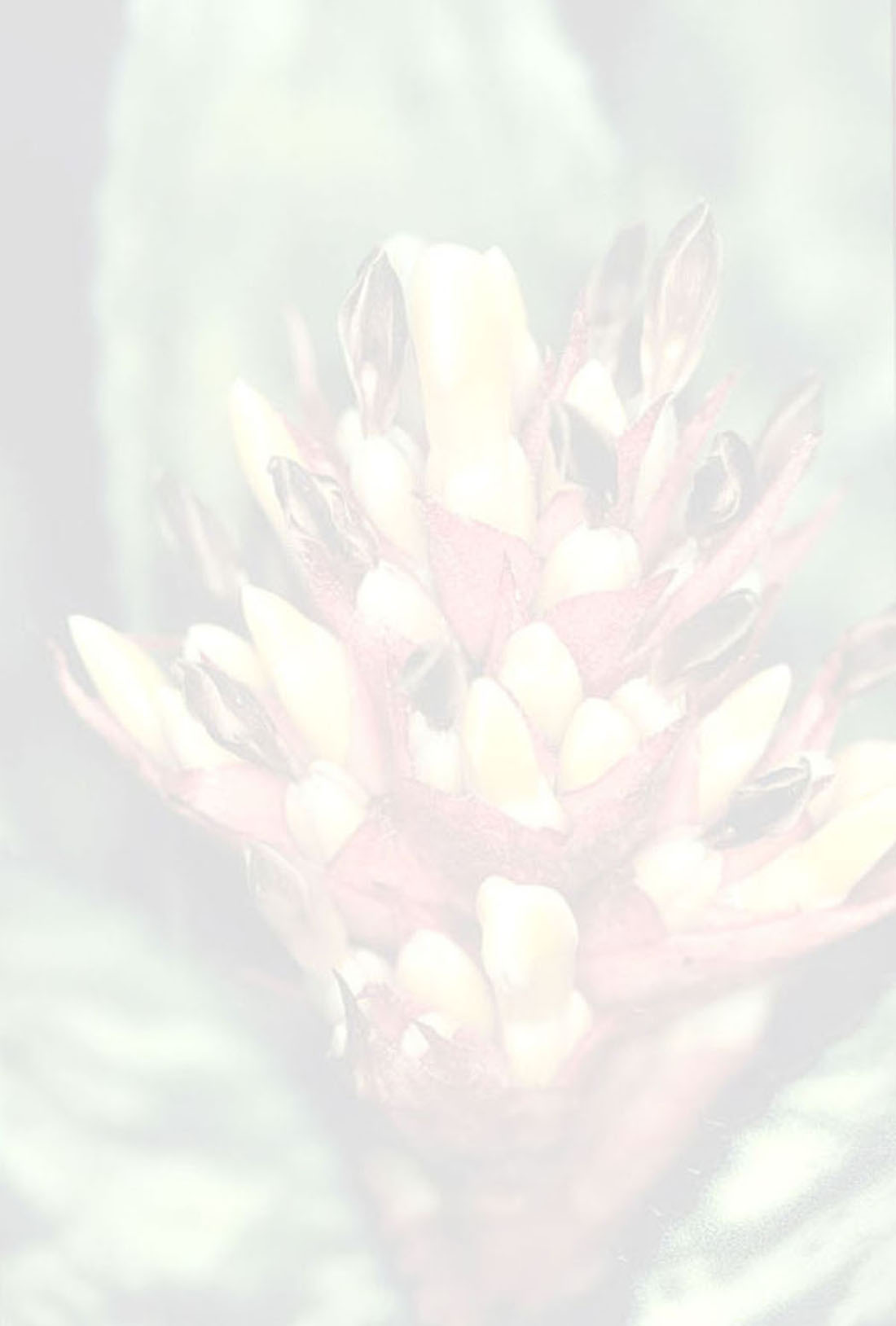

 Aechmea hoekelii Regel[as Aechmea hoekelii ]
Aechmea hoekelii Regel[as Aechmea hoekelii ]Diagnose: —Acaulis. Folia omnis radicalia rosulata, supra glabra, infra punctulis albidis sparsis vestitis, foliorum basis spathacea circiter 20 cm longa, 13 cm lata, margine integerrima: lamina concava 60-80 cm longa, medio 9 cm lata, apice in spinam excurrens, margine breviter spinuloso-dentata, denticulis horizontalibus vix 2 mm longis. Scapus circiter 1 m altus, paniculam tripinnato-ramosam gerens, ut rhachis albido-floccoso-pubescens. Scapi pars inferior simplex usque 40 cm alta, bracteis anguste lanceolatis acuminatis membranaceis 10-11 cm longis et 2 cm latis, latere inferiore albido-flocosso-pubescentibus, latere superiore glabris subimbricato-vestita; pars superior (rhachis primaria) paniculato-pyramidali-ramosa circiter 50cm longa, bracteis similibus decrescentibus ad ramosum basi vertita. Paniculae rami subhorizonaliter patentes, decrescentes, inferiores usquc 15 cm longi breviter ramulosi, ad basin ramulorum bracteola minima 1.5 mm longa e basi dilatata subito in mucronem exserta muniti. Ramuli paniculae l-5 flori; flores tcrminales semper, flores inferiores saepissime ramulo unifloro (pedunculo) circiter l-1.5 cm longo stipitati, florest laterales intcrmedii sessiles, bracteolis iis ramorum similibus circiter l mm longis fulti. Calycis limbus superus, incluso ovario pallide carneus, glaber, 3-partitus, 1.5 cm longus: segmenta ovalia, obtusa, dorso sub apice mucrone subulato rubro fusco l mm longo vertita, marginibus sese ambientibus. Petala 3, oblonga, acuta, supera, quam sepala 4-5 mm longiora, atropurpurea. Stamina 6, petalis breviora; 3 exteriora pctalis adnata, 3 interiora libera linearia . Antherae lineares, medio dorsi insertae, longitudinalitcr biloculares, Stylus terminalis, staminibus brcvior, stigmati ovati trilobi lobia spiraliter convolutes. Ovarium inferum triloculare, loculis multiovulatis. Ovula ovata, appendicula oblonga terminata, placenta parietali sub apice loculorum inserta. Observations: —In the supplement of the species of the genus Aechmea, Dr. Baker in Henry Trimens Journal of Botany vol. 17 showed our plant first with Aechmea mexicana Baker, Aechmea spectabilis Brongn. and Aechmea cymoso-paniculata Baker.
Of these, Dr. Baker recently had described in detail Aechmea mexicana in Gardeners Chronicle (1887 t. I p. 8) after a living specimens, which came to flower in the Botanical Garden at Kew, that had bracts similar to our plant, while the same in Trimens Journ. of Bot. t. l7 p. 165 says: "Well marked in the group by its obsolete flower bracts". However, it differs immediately by the long cylinder panicle, that is only 30 cm long, side branches only 5-7.5 cm long, the ovary and calyx dense woolly hairy and whose flowers all have a 6 mm long pedicel.
Aechmea spectabilis Brongn. (Revue Hort. 1875 with p. 311 icône. - Pironneava spectabilis K. Koch - Guzmannia spectabilis hort.) This is close to our plant, similar in being partly sessile, on the side, some at the top are basal, single flowered branches with sessile flower, which are carmine red colored, also all parts of the bracts at the base of the flowers are much larger. Detailed description is missing, and for the lover of the botanical description the petals rounded at the top still as long as the calyx. Also Dr. Baker saw only a leaf of the type.
Aechmea cymoso-paniculata Baker (l c. p. 165). Is distinguished by flowers of a pyramidal panicle that has a stiff pedicel 7-24 mm long, also the sepals are narrow deltoidish, with an upright standing, placed at the tip (but it is not said, placed on the tip or under the tip), and the sepals along with the ovary are only 7 mm long, so are twice as short as the other plant. No more examples were compared. If there is doubt as to the characters given by Dr. Baker, then we believe our plant is distinct from Aechmea cymoso-paniculata.Translated by Derek Butcher (04-06-2014) from: Regel 1887. Aechmea Hökeli Rgl. n.sp. .